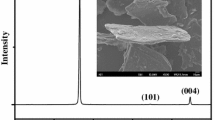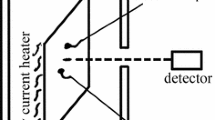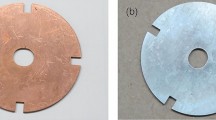Abstract
In this study, the emissivity of the wire arc directed energy deposition manufactured part made by 7075 nano-treated (NT) aluminum alloy during the continuous air-cooling process was experimentally examined, followed by a comprehensive investigation of the factors including surface texture, viewing angle, temperature, and surface condition on the emissivity gradient. For this purpose, a topography scanner and multiple temperature sensors were used, and a dedicated on-site temperature capture apparatus was designed to perform topography and temperature measurements. The emissivity gradient during the continuous air-cooling process is examined and the effect of the surface texture, viewing angle, and temperature is analyzed. The results indicate that the surface texture, which is mainly derived from the surface waviness along the part’s building direction, has a significant effect on the emissivity. In addition, the emissivity gradients for different surface conditions, such as polished and coated surfaces, were also studied. Finally, regression models with high fitting accuracy were developed for predicting the emissivity of 7075NT aluminum alloy parts once surface texture, surface condition and temperature were given.















Similar content being viewed by others
References
Rodrigues TA, Duarte V, Miranda RM, Santos TG, Oliveira JP (2019) Current status and perspectives on wire and arc additive manufacturing (WAAM). Materials (Basel) 12:1121. https://doi.org/10.3390/ma12071121
Prado-Cerqueira JL, Diéguez JL, Camacho AM (2017) Preliminary development of a wire and arc additive manufacturing system (WAAM). Procedia Manuf 13:895–902. https://doi.org/10.1016/j.promfg.2017.09.154
Xiong J, Zhang G, Hu J, Wu L (2014) Bead geometry prediction for robotic GMAW-based rapid manufacturing through a neural network and a second-order regression analysis. J Intell Manuf 25:157–163. https://doi.org/10.1007/s10845-012-0682-1
Richter A, Gehling T, Treutler K, Wesling V, Rembe C (2021) Real-time measurement of temperature and volume of the weld pool in wire-arc additive manufacturing. Meas Sensors 17:100060. https://doi.org/10.1016/j.measen.2021.100060
Gierth M, Henckell P, Ali Y, Scholl J, Bergmann JP (2020) Wire arc additive manufacturing (WAAM) of aluminum alloy AlMg5Mn with energy-reduced gas metal arc welding (GMAW). Materials (Basel) 13:2671. https://doi.org/10.3390/ma13122671
Geng H, Li J, Xiong J, Lin X (2017) Optimisation of interpass temperature and heat input for wire and arc additive manufacturing 5A06 aluminium alloy. Sci Technol Weld Join 22:472–483. https://doi.org/10.1080/13621718.2016.1259031
Derekar K, Lawrence J, Melton G, Addison A, Zhang X, Xu L (2019) Influence of interpass temperature on wire arc additive manufacturing (WAAM) of aluminium alloy components. Matec Web Conf 269:05001. https://doi.org/10.1051/matecconf/201926905001
Martina F, Colegrove PA, Williams SW, Meyer J (2015) Microstructure of interpass rolled wire + arc additive manufacturing components. Metall Mater Trans A Phys Metall Mater Sci 46:6103–6118. https://doi.org/10.1007/s11661-015-3172-1
Szost BA, Terzi S, Martina F, Boisselier D, Prytuliak A, Pirling T, Hofmann M, Jarvis DJ (2016) A comparative study of additive manufacturing techniques: residual stress and microstructural analysis of CLAD and WAAM printed Ti-6Al-4V components. Mater Des 89:559–567. https://doi.org/10.1016/j.matdes.2015.09.115
Queguineur A, Rückert G, Cortial F, Hascoët JY (2018) Evaluation of wire arc additive manufacturing for large-sized components in naval applications. Weld World 62:259–266. https://doi.org/10.1007/s40194-017-0536-8
Kim J, Kim J, Pyo C (2020) Comparison of mechanical properties of Ni-Al-bronze alloy fabricated through wire arc additive manufacturing with Ni-Al-bronze alloy fabricated through casting. Metals (Basel) 10:1164. https://doi.org/10.3390/met10091164
Treutler K, Wesling V (2021) The current state of research of wire arc additive manufacturing (WAAM): a review. Appl Sci 11:8619. https://doi.org/10.3390/app11188619
Jafari D, Vaneker THJ, Gibson I (2021) Wire and arc additive manufacturing: opportunities and challenges to control the quality and accuracy of manufactured parts. Mater Des 2021:109471. https://doi.org/10.1016/j.matdes.2021.109471
WagimanBin WahabMohidMamat AMSZS (2014) Effect of GMAW-CMT heat input on weld bead profile geometry for freeform fabrication of aluminium parts. Appl Mech Mater 465–466:1370–1374. https://doi.org/10.4028/www.scientific.net/AMM.465-466.1370
Xiong J, Zhang G, Zhang W (2015) Forming appearance analysis in multi-layer single-pass GMAW-based additive manufacturing. Int J Adv Manuf Technol 80:1767–1776. https://doi.org/10.1007/s00170-015-7112-4
Gomez Ortega A, Corona Galvan L, Deschaux-Beaume F, Mezrag B, Rouquette S (2018) Effect of process parameters on the quality of aluminium alloy Al5Si deposits in wire and arc additive manufacturing using a cold metal transfer process. Sci Technol Weld Join 23:316–332. https://doi.org/10.1080/13621718.2017.1388995
Carter W, Masuo C, Nycz A, Noakes M, Vaughan D (2019) Thermal process monitoring for wire-arc additive manufacturing using IR cameras, Solid freeform fabrication 2019: Proceedings 30th annual international solid freeform fabrication symposium–an additive manufacturing conferenc SFF, 1812–1817
Yang D, Wang G, Zhang G (2017) Thermal analysis for single-pass multi-layer GMAW based additive manufacturing using infrared thermography. J Mater Process Technol 244:215–224. https://doi.org/10.1016/j.jmatprotec.2017.01.024
Edition S (2015) Fundamentals of heat and mass transfer.https://doi.org/10.1007/978-3-319-15793-1_19
Murphy RD, Forrest EC (2016) A review of in-situ temperature measurements for additive manufacturing technologies. National Conference of State Legislatures 2016
Nunak T, Rakrueangdet K, Nunak N, Suesut T (2015) Thermal image resolution on angular emissivity measurements using infrared thermography. Proceedings of the international multiconference of engineers and computer scientists 2015 vol I, IMECS 2015
Da Wen C (2010) Investigation of steel emissivity behaviors: examination of multispectral radiation thermometry (MRT) emissivity models. Int J Heat Mass Transf 53:2035–2043. https://doi.org/10.1016/j.ijheatmasstransfer.2009.12.053
Meola C, Boccardi S, Carlomagno GM (2017), Infrared thermography basics, infrared thermogr. Eval Aerosp Compos Mater 57–83. https://doi.org/10.1016/b978-1-78242-171-9.00003-6.
Bock JJ, Parikh MK, Fischer ML, Lange AE (1995) Emissivity measurements of reflective surfaces at near-millimeter wavelengths. Appl Opt 34:4812. https://doi.org/10.1364/ao.34.004812
Meola C, Boccardi S, Carlomagno GM, (2017) Composite materials in the aeronautical industry, In: Infrared thermography in the evaluation of aerospace composite materials, Elsevier, pp 1–24. https://doi.org/10.1016/B978-1-78242-171-9.00001-2.
Wen C-D, Mudawar I (2006) Modeling the effects of surface roughness on the emissivity of aluminum alloys. Int J Heat Mass Transf 49:4279–4289. https://doi.org/10.1016/j.ijheatmasstransfer.2006.04.037
Olioso A, Mira M, Courault D, Marloie O, Guillevic P (2013) Impact of surface emissivity and atmospheric conditions on surface temperatures estimated from top of canopy brightness temperatures derived from Landsat 7 data, In: 2013 IEEE International Geoscience and Remote Sensing Symposium-IGARSS, IEEE, pp 3033–3036. https://doi.org/10.1109/IGARSS.2013.6723465
Meola C, Boccardi S, Carlomagno GM, (2017) Infrared thermography basics, In: Infrared thermography in the evaluation of aerospace composite materials, Elsevier, pp 57–83. https://doi.org/10.1016/B978-1-78242-171-9.00003-6.
Maturilli A, Helbert J, Ferrari S, D’Amore M (2016) On the effect of emergence angle on emissivity spectra: application to small bodies, Earth Planets Special 68:. https://doi.org/10.1186/s40623-016-0464-7.
Lanc Z, Štrbac B, Zeljković M, Živković A, Hadžistević M (2018) Emissivity of aluminium alloy using infrared thermography technique. Mater Tehnol 52:323–327. https://doi.org/10.17222/mit.2017.152
Da Wen C, Mudawar I (2004) Emissivity characteristics of roughened aluminum alloy surfaces and assessment of multispectral radiation thermometry (MRT) emissivity models. Int J Heat Mass Transf 47:3591–3605. https://doi.org/10.1016/j.ijheatmasstransfer.2004.04.025
Cao MCC, Pan S, Li X (2019) Nanoparticle-enabled phase control for arc welding of unweldable aluminum alloy 7075. Nat. Commun. 10:1–8. https://doi.org/10.1038/s41467-018-07989-y
Zuo M, Sokoluk M, Cao C, Yuan J, Zheng S, Li X (2019) Microstructure control and performance evolution of aluminum alloy 7075 by nano-treating. Sci Rep 9:10671. https://doi.org/10.1038/s41598-019-47182-9
Xiong J, Li Y, Li R, Yin Z (2018) Influences of process parameters on surface roughness of multi-layer single-pass thin-walled parts in GMAW-based additive manufacturing. J Mater Process Technol 252:128–136. https://doi.org/10.1016/j.jmatprotec.2017.09.020
Geng H, Li J, Xiong J, Lin X, Huang D, Zhang F (2018) Formation and improvement of surface waviness for additive manufacturing 5A06 aluminium alloy component with GTAW system. Rapid Prototyp J 24:342–350. https://doi.org/10.1108/RPJ-04-2016-0064
Samadian K, De Waele W (2020) Fatigue crack growth model incorporating surface waviness for wire+arc additively manufactured components. Procedia Struct Integr 28:1846–1855. https://doi.org/10.1016/j.prostr.2020.11.008
Shi D, Xing W, Sun J, Zhu Z (2018) Emissivity model of aluminum 7075 during the growth of oxide layer over the temperature range from 800 to 910 K at a wavelength of 1.5 μm. Trans. Indian Inst. Met. 71:1049–1060. https://doi.org/10.1007/s12666-017-1239-y
ISO 10904 (2004) International Standard ISO 25178–2 Geometrical product specifications (GPS) — Surface texture: Areal — 2003
Hu J, Liu Z, Zhao J, Wang B, Song Q (2021) Theoretical modeling and analysis of directional spectrum emissivity and its pattern for random rough surfaces with a matrix method. Symmetry (Basel) 13:1733. https://doi.org/10.3390/sym13091733
Sobrino JA, Cuenca J (1999) Angular variation of thermal infrared emissivity for some natural surfaces from experimental measurements. Appl Opt 38:3931. https://doi.org/10.1364/AO.38.003931
Imran M, Khan ARA (2019) Characterization of Al-7075 metal matrix composites: a review. J Mater Res Technol 8:3347–3356. https://doi.org/10.1016/j.jmrt.2017.10.012
Sokoluk M, Cao C, Pan S, Li X (2019) Nanoparticle-enabled phase control for arc welding of unweldable aluminum alloy 7075. Nat Commun 10:98. https://doi.org/10.1038/s41467-018-07989-y
Acknowledgements
Funding provided by several agencies, including the Natural Sciences and Engineering Research Council of Canada (NSERC) grant number NSERC ALLRP 561,049–20, and Alberts Innovates ADVANCE 202,102,751 Q is highly appreciated.
Author information
Authors and Affiliations
Contributions
Shiyu Teng: Shiyu Teng: conducting experiments, experimental investigation, conceptualization, analysis, and writing the original draft. Shirin Dehgahi: review and editing, co-supervision. Hani Henein: supervision. Tonya Wolfe: supervision. Ahmed Qureshi: funding acquisition, project administration, supervision, reviewing the draft, conceptualization of the project, directing experimental design.
Corresponding author
Ethics declarations
Competing interests
The authors declare no competing interests.
Additional information
Publisher's Note
Springer Nature remains neutral with regard to jurisdictional claims in published maps and institutional affiliations.
Rights and permissions
Springer Nature or its licensor (e.g. a society or other partner) holds exclusive rights to this article under a publishing agreement with the author(s) or other rightsholder(s); author self-archiving of the accepted manuscript version of this article is solely governed by the terms of such publishing agreement and applicable law.
About this article
Cite this article
Teng, S., Dehgahi, S., Henein, H. et al. Effect of surface texture, viewing angle, and surface condition on the emissivity of wire arc directed energy deposition manufactured 7075 nano treated aluminum alloy. Int J Adv Manuf Technol 126, 2175–2189 (2023). https://doi.org/10.1007/s00170-023-11208-4
Received:
Accepted:
Published:
Issue Date:
DOI: https://doi.org/10.1007/s00170-023-11208-4




